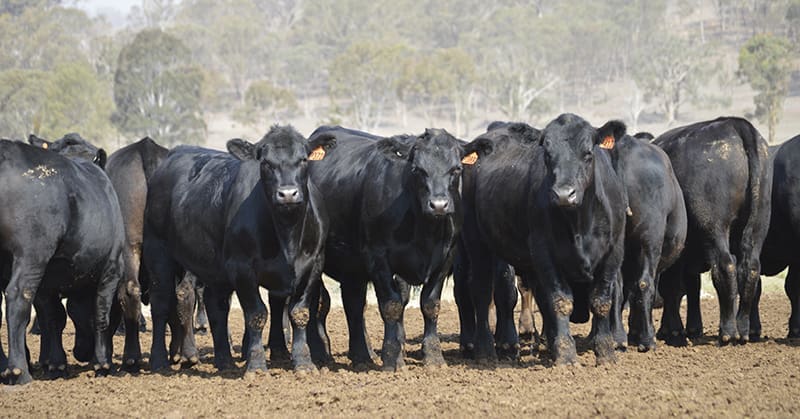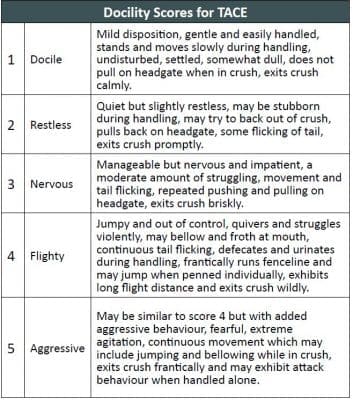
THE importance of docility as a beef cattle trait was highlighted in a recent survey of more than 1200 beef producers across Australia, which found temperament was the most important trait when selecting a bull.
Docility measurements are typically taken at weaning, which has the advantage of all calves having had minimal handling, allowing them to express variation in their temperament. This variation is important, because a big part of the temperament seen in animals is the result of their past handling.
In order to make gains in docility, it’s necessary to record the trait, because it is only with the accurate description of the trait that selection decisions can be made without the impact of non-genetic factors. By recording docility, we have the potential to benefit from improved temperament.
The temperament of an animal has a big impact on its value within a beef operation and when temperament is discussed, we are talking about the way animals behave when being confined or exposed to usual situations (e.g. being separated from the herd). The benefits of a superior temperament in cattle are well understood and include:
- Lower production costs
- Make cattle easier to muster and handle
- Reduce damage to infrastructure g. yards and fences
- Decrease risk of injury and stress to cattle
- Decrease risk of injury and stress to stock handlers
- Decrease weight loss during transit
- Improve feedlot performance
- Decrease the risk of dark cutters in the chillers. It is estimated that dark cutting beef costs the Australian beef industry $36 million annually
- Improve eating quality (more tender beef)
For seedstock producers, temperament is of particular importance due to the significant impact it has on the profitability of their clients’ operations. Importantly, temperament is highly heritable and lacks any known antagonistic genetic relationships, meaning improvements can be made in temperament without impacting negatively on other traits within the breeding objective.
Using the Angus breed as an example, docility scores taken on calves between 60 and 400 days of age are used to calculate Docility EBVs within the TransTasman Angus Cattle Evaluation (TACE).
Recording docility scores
Animals can be scored for docility using either a crush or yard test:
- Crush Test – Calves are put up a race and held in a crush or weigh scales for a minimum of 10 seconds (but not necessarily head bailed).
- Yard Test – Calves are individually put into a small square yard and the handler attempts to hold the animal in one corner for a minimum of 10 seconds.
While docility scores from both scoring systems are acceptable, the crush test is more commonly used as animals can be scored when moving through the crush for other purposes (e.g. weighing, animal health treatments).
Docility score descriptions

When using either the crush or yard test, the behaviour of animals should be observed and animals scored using the criteria displayed in the following table.
Half scores (i.e. 1.5, 2.5, 3.5, 4.5) can be used to identify animals who exhibit behaviour which is intermediate to the scores listed.
In a ‘normal’ Angus beef herd where the majority of animals have acceptable temperament, it would be expected that the majority of animals would have a score of 1, 1.5 or 2, with a small percentage of animals receiving a score of 2.5 and above.
When should animals be scored?
Docility scores in Angus must be recorded when animals are between 60 and 400 days of age for inclusion in TACE.
The recommended time of scoring is at weaning or shortly afterwards. The advantage of scoring at weaning is that all calves should have had minimal handling and so will express variation in temperament. Variation in handling between animals prior to scoring should also be minimised.
Only one docility score can be analysed in TACE for each individual animal.
Tips on collecting docility information
- There needs to be some variation in scores for them to be used in the TACE analysis. Scoring all animals in a group with a docility score of [1] does not identify any differences in docility between animals, and consequently does not provide any useful information for the calculation of Docility EBVs.
- Docility scores should be collected for all animals in a contemporary group. Only recording docility scores for a subset of animals is of no value and can lead to biased Docility EBVs.
- All animals in a contemporary group should be scored on the same day. TACE will not directly compare the docility scores of animals that have been scored on different days.
- Docility scores should be collected when animals are in as large a group as possible. Consequently, try to collect docility scores before any of the animals in a management group are treated differently.
- If any animals being scored on a particular day have had a different level of handling prior to scoring, they should be assigned a different “docility management group”.
- The method of scoring used (i.e. crush or yard) should be specified when submitting the docility scores.
- It is important that both a consistent scoring method is used and the same person scores all animals that are being assessed in the herd on a particular day.
- While more than one docility score can be recorded for an individual animal, TACE is only analysing the first docility score for each animal at this stage.
Source: Angus Australia



HAVE YOUR SAY